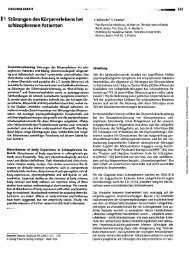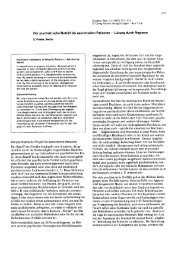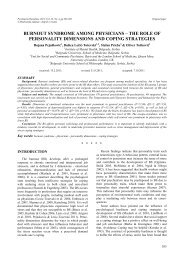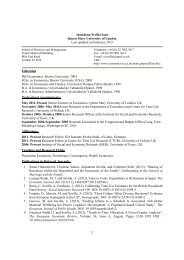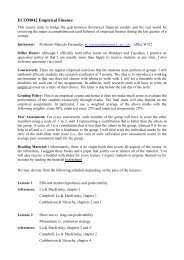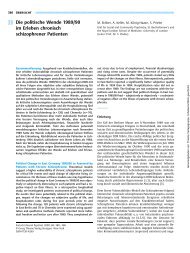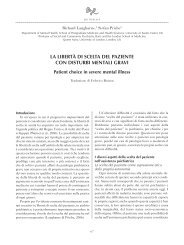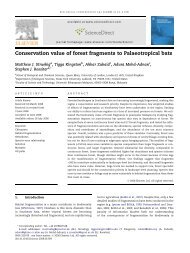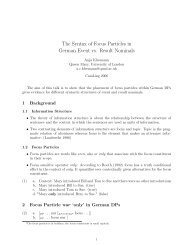Proofs - Personal Webspace for QMUL - Queen Mary, University of ...
Proofs - Personal Webspace for QMUL - Queen Mary, University of ...
Proofs - Personal Webspace for QMUL - Queen Mary, University of ...
You also want an ePaper? Increase the reach of your titles
YUMPU automatically turns print PDFs into web optimized ePapers that Google loves.
S34 A. Heinz et al. / European Psychiatry 27 (2012) / supplement n°2 / S32-S43<br />
these ideas or impressions? And how can you avoid that “the<br />
series goes on to infi nity”, i.e. an infi nite regress, in which the<br />
entity that perceives an impression, is itself unconscious and in<br />
order to become conscious in turn, becomes again the object <strong>of</strong><br />
a higher entity which experiences it?<br />
3. Classical theories <strong>of</strong> self- consciousness:<br />
Hume versus Kant<br />
In his “Treatise <strong>of</strong> human nature”, Hume avoided the infi nite<br />
regress by suggesting that there is no inner self or entity which<br />
perceives an impression. For Hume (1978), there was no identical<br />
self but only a stream <strong>of</strong> ever changing impression: “I can never<br />
catch myself at any time without a perception, and never can<br />
observe anything but the perception” [27]. He thus suggested<br />
that there is no independent observer outside <strong>of</strong> this “bundle <strong>of</strong><br />
perceptions”. Hume compared the mind with a theatre scene<br />
without spectators. He suggested that different impressions fl ow<br />
into each other without clear boundaries and this may be the<br />
reason why we attribute an identity to this ever changing stream<br />
and miss the truth – that there is nothing but the perceptions:<br />
“Thus we feign the continued existence <strong>of</strong> the perception <strong>of</strong> our<br />
senses, to remove the interruption; and run into the notion <strong>of</strong><br />
a soul, and self, and substance, to disguise the variation” [27].<br />
Hume suggested that we feel an association between the different<br />
perceptions when our thinking focuses on one after the other.<br />
However, since there is no link that can be perceived between<br />
the different ideas and impressions, Hume remained a sceptic<br />
with respect to personal identity. He criticised that personal<br />
identity requires a “unity <strong>of</strong> consciousness”, a concept which<br />
Hume did not accept: “I cannot explain the principles that unite<br />
our successive perceptions in our thought or consciousness” [27].<br />
Kant (1966) proposed a different solution <strong>of</strong> this problem.<br />
He suggested that there is a kind <strong>of</strong> personal ownership <strong>of</strong> one’s<br />
own thoughts, which is not refl ected in a (separate) perceptive<br />
act. Instead, this ownership rather resembles a disposition: “The:<br />
I think, must be able/poised to accompany all my ideas… This<br />
idea [<strong>of</strong> a thinking self] in itself is an act <strong>of</strong> spontaneity, i.e. it can<br />
not be understood as belonging to sense perception” [31, §16].<br />
Kant suggested that my ideas would not be “my” ideas, if they<br />
could not stand together in a “common self- consciousness” and<br />
thus belong to me. Kant agreed with Hume that the empirical<br />
consciousness that accompanies different ideas is in itself dispersed<br />
and without a clear relation to the identity <strong>of</strong> the subject.<br />
Nevertheless, Kant assumed that the association between the<br />
ideas is created by the subject, who places one idea to the other<br />
and who is aware <strong>of</strong> the “synthesis” <strong>of</strong> these ideas. The association<br />
would not be in the objects itself and cannot be perceived<br />
by the senses and thus be transferred into the mind; instead,<br />
according to Kant, the association is a capacity <strong>of</strong> the intellect<br />
(Verstand), which in itself is nothing but the ability to associate<br />
‘a priori’. In other words, Kant may ask the question: if one <strong>of</strong><br />
my perceptions is not “my” perception, how could I refl ect on<br />
it? Ownership <strong>of</strong> ideas is thus a capacity <strong>of</strong> the intellect, not a<br />
quality to be perceived. For Kant, the identity <strong>of</strong> consciousness<br />
is a necessary precondition <strong>for</strong> the association <strong>of</strong> perceptions (a<br />
priori), and not, as suggested by Hume, a misconception arising<br />
a posteriori from the stream <strong>of</strong> ideas and impressions.<br />
However triumphant Kant may be considered to have been<br />
over Hume, he turned out to be unable to deliver a clear analysis<br />
<strong>of</strong> what the structure <strong>of</strong> selfhood actually consists in and how<br />
our mind can come to cognize itself. In the Critique <strong>of</strong> Pure Reason<br />
he wrote: ‘Now it is, indeed, very evident that what I must<br />
presuppose in order to cognize an object at all, cannot itself be<br />
cognized as an object [….]` [31, A, 402]. In the paralogism chapter<br />
<strong>of</strong> the Critique Kant had repeatedly described the diffi culty <strong>of</strong><br />
apperception, <strong>of</strong> grasping oneself not via objectual representation,<br />
but as such, roughly as follows: In trying to say who I am, I<br />
must self- ascribe some, <strong>for</strong> example perceptual, properties. As<br />
soon as I question about the legitimacy <strong>of</strong> these attributions,<br />
however, it becomes clear that I could only make them if I was<br />
previously already familiar with the meanings <strong>of</strong> ‘I’or ‘my’. So I<br />
feel compelled to choose myself (or the concept ‘I’) as the ‘correlate<br />
<strong>of</strong> my comparisons’, which should resolve <strong>for</strong> me which<br />
property defi nes me. Yet, in this way I presuppose exactly that<br />
which I had laid claim to bring to knowledge [31, A, 366, 345ff].<br />
Elsewhere Kant stresses that ‘I’ is in fact not a concept but rather<br />
a perception or even a feeling (e.g. [32], further references and<br />
an interpretation <strong>of</strong> this confl ict see [15].<br />
The fi rst to have not only clearly articulated but also proposed<br />
a solution to Kant’s problem was Johann Gottlieb Fichte<br />
in 1797. He fi rst spotted the failure <strong>of</strong> what hence<strong>for</strong>th has been<br />
called the refl ection- model <strong>of</strong> self- consciousness. This model<br />
implies that self- consciousness comes about either through<br />
“direct” consciousness <strong>of</strong> the I as an object (egological version), or<br />
through a kind <strong>of</strong> higher- order consciousness which is directed<br />
towards a fi rst order consciousness (non- egological version).<br />
In this way consciousness discovers itself in the position <strong>of</strong> an<br />
object. And since, according to this model, all knowledge consists<br />
<strong>of</strong> knowledge <strong>of</strong> objects (whether <strong>of</strong> individuals, universals<br />
or facts), self- knowledge too is explained as knowledge <strong>of</strong> a<br />
particular type <strong>of</strong> object.<br />
Let us fi rst consider the egological version <strong>of</strong> this refl ectiontheory.<br />
According to it the “I” obtains knowledge <strong>of</strong> itself through<br />
refl ection – through entering into a refl ective relation with itself,<br />
and thereby, as it were, “setting its eyes on itself”. However,<br />
if it holds that there is knowledge only <strong>of</strong> phenomena which<br />
occupy an object- position in relation to a knower, and if what<br />
we are after is the I as a subject, not as an object, then there<br />
seems to be no way <strong>for</strong> the I to have knowledge <strong>of</strong> itself. In fact,<br />
the refl ection- theory, as Kant takes it over from Descartes and<br />
Leibniz (but also from numerous thinkers <strong>of</strong> British empiricism,<br />
see Frank [15]), must then presuppose the phenomenon whose<br />
structure it assumes to explain. It was <strong>for</strong> this reason that Fichte<br />
accused it <strong>of</strong> ‘sophistry’ in his lectures on the Wissenschaftslehre<br />
nova methodo [12].<br />
What about the non- egological version <strong>of</strong> the refl ection<br />
theory? If self- consciousness only came about through a ‘piling<br />
up’ <strong>of</strong> consciousnesses, where a lower- order consciousness was<br />
attested to by a higher- order consciousness, then there would be<br />
no self- consciousness at all. This is because <strong>for</strong> the “top” <strong>of</strong> the<br />
chain <strong>of</strong> refl ected consciousnesses, the same condition would<br />
once again apply whereby in order <strong>for</strong> it to become conscious<br />
<strong>of</strong> itself, it would have to be made into an object by a successive<br />
consciousness, which again would be non- self- conscious, and so<br />
on ad infi nitum (see also Sartre [51]). Thus we arrive back at the<br />
infi nite teatess Aristoteles identifi ed and tried to avoid.<br />
<strong>Pro<strong>of</strong>s</strong>




